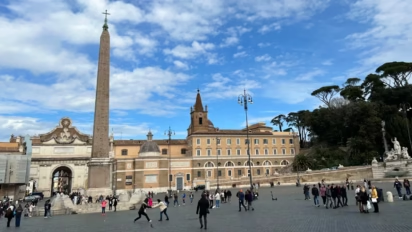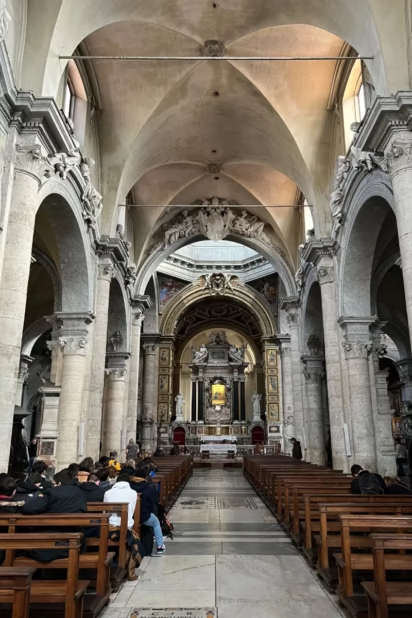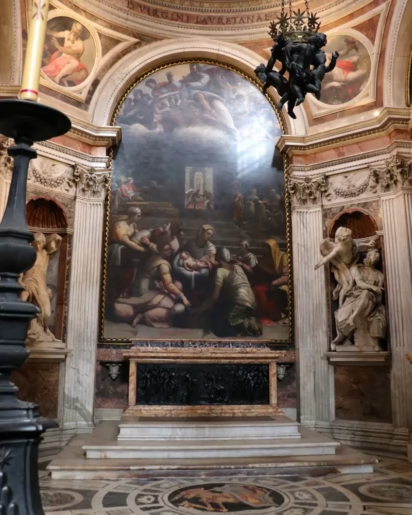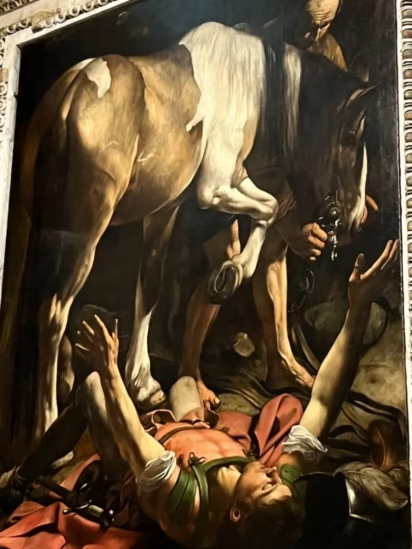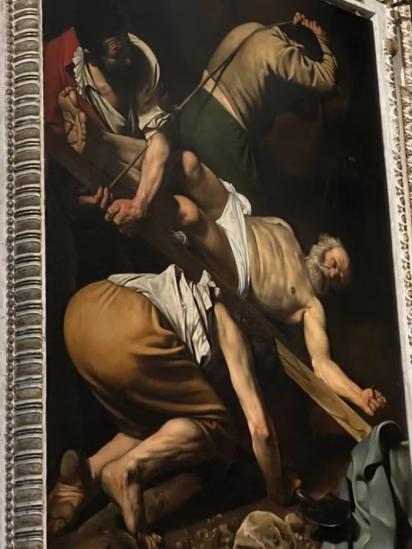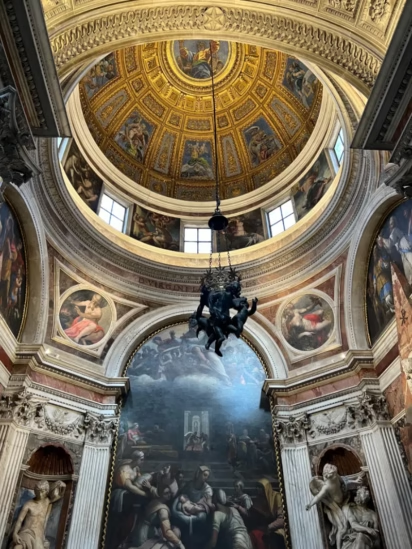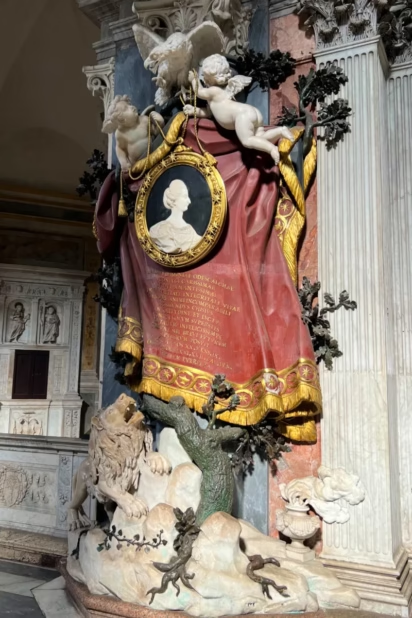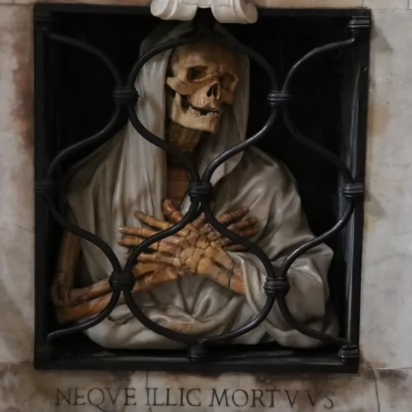See top art by Caravaggio (Crucifixion of St Peter, Conversion of St Paul), Bernini, and Raphael for free in the Santa Maria del Popolo church in Rome.

The church of Santa Maria del Popolo is one of the top free churches to visit in Rome to see exceptional art. The main attractions for most are the paintings Crucifixion of St Peter and Conversion of St Paul by Caravaggio in the Cerasi Chapel. The Chigi Chapel was designed and decorated by Raphael while Bernini’s baroque influence is seen in many parts of the church.
Santa Maria del Popolo Church in Rome
The Santa Maria del Popolo church is one of the most prominent churches in Rome and often benefited from wealthy and powerful sponsors. Although it is only a minor basilica, it was for centuries the first church that most pilgrims visited when arriving in the eternal city.
Martin Luther, still a practicing Catholic and Augustinian monk, passed by around Christmas 1510.
From the outside, Santa Maria del Popolo is fairly plain and totally overshadowed by the huge Piazza del Popolo with its tall Egyptian obelisk, the third-century Aurelian wall with the much newer Bernini revamped Porta del Popolo gate, and the two domed churches on the opposite end of the square. Although the large oval-shaped piazza and Baroque buildings are impressive, none can compare with the art on offer inside the Santa Maria del Popolo.
The first church was erected here in 1099, according to legend to still the wandering spirit of Emperor Nero who was buried nearby, but the current mostly Renaissance church dates from the late 15th century. The floorplan (triple-nave basilica with side chapels and non-protruding transept) and modified facade are mostly due to the influence of Bernini, who updated the church at the behest of Pope Alexander VII (mid-17th century).
Bernini planned a grander (and busier) interior but his full plans were never implemented and the interior was somewhat simplified in the early 20th century when attempts were made to return the church to a more Renaissance look.
Caravaggio and Other Artists in the Santa Maria del Popolo
Taste in art has changed through the centuries. When visiting Santa Maria del Popolo, it is worth keeping in mind that the best artists of the times were employed to decorate the chapels. Some artists fell into obscurity in later years but may make a comeback in the future. In previous centuries, Raphael, Bernini, and Caravaggio were out of fashion and it is only since the mid-20th century that Bernini and Caravaggio, for example, are again considered among the highlights to visit in this church.
The church also has works by Donate Bramante (who designed the apse), Pinturicchio, Lorenzetto, Mino da Fiesole, Giulio Mazzoni, Annibale Carracci, Raffaello Vanni, and others.
According to tradition, St Luke painted the image of the Virgin displayed on the main altar — she’s certainly revered by the religious but still most visitors appreciate the Carvaggios more.
Caravaggio Paintings in Santa Maria del Popolo


Caravaggio was contracted to paint two large lateral paintings for the Cerasi chapel, to the left of the main altar of Santa Maria del Popolo. The large central painting of the Assumption of the Virgin Mary by Annibale Carracci was acquired at the same time. Both Carracci and Caravaggio were successful and highly rated artists at the time but it is without doubt that visitors mainly visit Santa Maria del Popolo to see the Caravaggios.
Both paintings are typical Caravaggios — light and dark but the former only shows when visitors feed coins into the box to switch on the lights:
Caravaggio: Conversion of St. Paul
Caravaggio’s Conversion of St. Paul — also The Conversion on the Way to Damascus (Conversione di San Paolo) — was commissioned by Monsignor Tiberio Cerasi, Treasurer-General to Pope Clement VIII, for the lateral wall of the newly acquired family chapel in the transept at the front of Santa Maria del Popolo. Caravaggio’s first attempt on wood in the busy style of the Martyrdom of Saint Mathew (in San Luigi), was rejected but Caravaggio sold it on. (It is now in the Odescalchi Balbi Collection in Rome.)
Caravaggio completed the second Conversion of Saint Paul in 1601 — it is an oil on canvas painting measuring 230 cm × 175 cm (91 in × 69 in). It is a far simpler composition than the first: just Paul flat on his back, his large horse filing most of the space, and an old assistant in the background. In contrast to the first version, he painted no God, no Roman soldiers, no beards, and no hands in front of the eyes.
Paul is on his back, legs splayed, and arms open to receive the message from God in the form of the bright light. The servant is in the background behind the horse (both with strong veins on their legs). Also, in contrast to the first version, Paul is shown as a beardless, relatively young man.
Caravaggio: Crucifixion of St. Peter
Caravaggio’s The Crucifixion of Saint Peter (Crocifissione di san Pietro) is of a similar size and was also completed in 1601. This was possibly also a second version, as the original commission was for a painting on wood rather than the current oil on canvas, but the records are less clear than for St Paul.
This painting shows Saint Peter being crucified upside down. According to tradition, Peter claimed that he was not worthy to die on the cross in a similar fashion to Jesus Christ. The apostle Peter, by now an old man, is shown already with his hands and feet nailed to the cross. Only a fairly small stone reminds that this is Peter, the rock on which the church is built. (Tu es Petrus in St Peter’s Basilica in the Vatican City.)
Three workers leverage the cross upright. The three anonymous men in workers’ clothes and dirty feet show no emotions or reverence — it is all in a day’s work.
The Chigi Chapel by Raphael and Bernini
The Chigi Chapel in Santa Maria del Popolo is the only religious building designed by Raphael to have been preserved in its original form. It is filled with art from the Renaissance (Raphael and Lorenzetto) and Baroque (Bernini).
In designing the dome for the chapel, Raphael was inspired by the Pantheon (which is no longer free). The dome mosaic illustrates the creation of the world. At the center is God the Father with the sun, moon, and six known planets in the eight surrounding panels. Typical for the Florentine Renaissance, the mosaics include the signs of the zodiac and Roman gods to identify the planets.
Raphael’s designs for further mosaics to illustrate the tambours and spandrels were never executed. Later oil paintings show for example the seasons and episodes from Genesis.
The marble statues of the prophets Jonah and Elijah are by Lorenzetto following the designs of Raphael. The other two sculptures, Daniel and the Lion and Habakkuk and the Angel show the vividness of Bernini’s work completed around 150 years later. Both Bernini sculptures struggle to be contained by the shell-headed niches that were already completed in the Renaissance.
For the Chigi Chapel, Bernini also added the colorful geometric pavement and the Marian-crown bronze lamp. The lunettes by Raffaello Vanni also date from the Baroque period.
More Art in Santa Maria del Popolo
The chapels and nave of Santa Maria del Popolo are full of further monuments, artworks, and decorations. Many items were altered or designed by Bernini such as some of the angels and saints high up in the nave and below the organ cabinets.
Several of the side chapels were originally for the Della Rovere family, which included Pope Sixtus IV and Pope Julius II, whose influence and grave monument with Michelangelo’s Moses fluence may be seen in St Peter in Chains, which was at the opposite end of Rome during their lifetimes.
The largest chapel is also interesting to see. The Cybo Chapel, second from the entrance to the right opposite the Raphael chapel. It was rebuilt in the 1680s and is considered one of the finest sacral monuments erected in Rome in the late 17th century. The main altar painting by Carlo Maratta depicts the Disputation over the Immaculate Conception — a sure way to get Protestant backs up in previous centuries. Many current visitors may find the colorful marble columns and revetments of more interest.
The funeral monument of Princess Maria Flaminia Odescalchi Chigi — also known as the last Baroque tomb in Rome — is the most exuberant grave monument in the church. The design by Paolo Posi (1772) was clearly inspired by Bernini. The oak tree was the symbol of the Chigis and is also seen multiple times elsewhere in the church.
See Caravaggio Paintings in Santa Maria del Popolo
Admission to Santa Maria del Popolo is free as is the norm with churches in Rome. Most of the art is seen for free too but it is necessary to feed the box some coins to switch on the lights in order to see the Caravaggio paintings in the Cerasi Chapel.
Santa Maria del Popolo is usually open daily from 7:00 to 12:30 and 16:00 to 19:00. Exact opening times sometimes change slightly and are posted on the door. Closures for services are less likely in the afternoons.
The church of Santa Maria del Popolo is on the Piazza del Popolo directly next to the Porto del Popolo triumphal arch gate that leads through the Aurelian walls from the third century. The closest metro is Flaminio — cross the road at the McDonalds to reach the gate.
